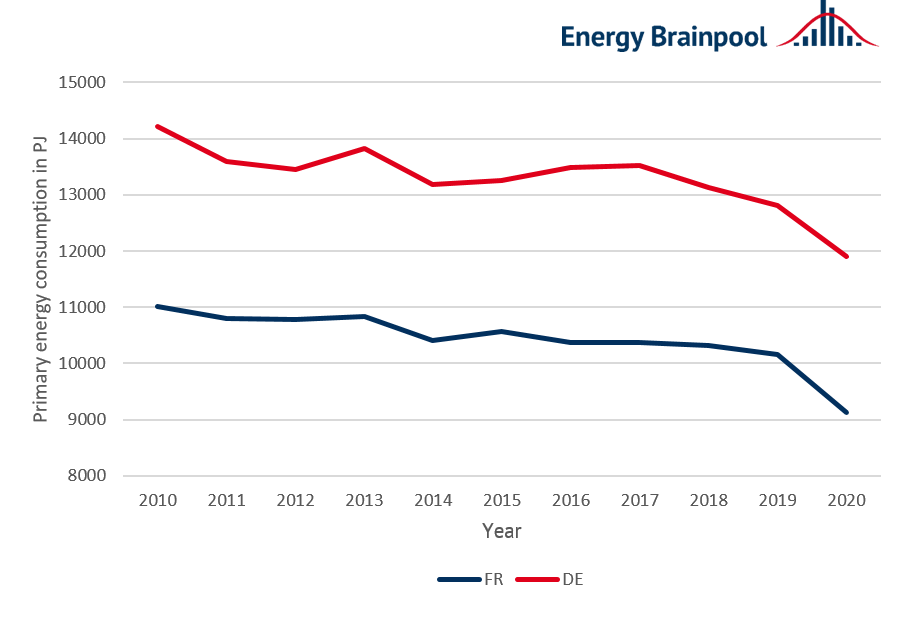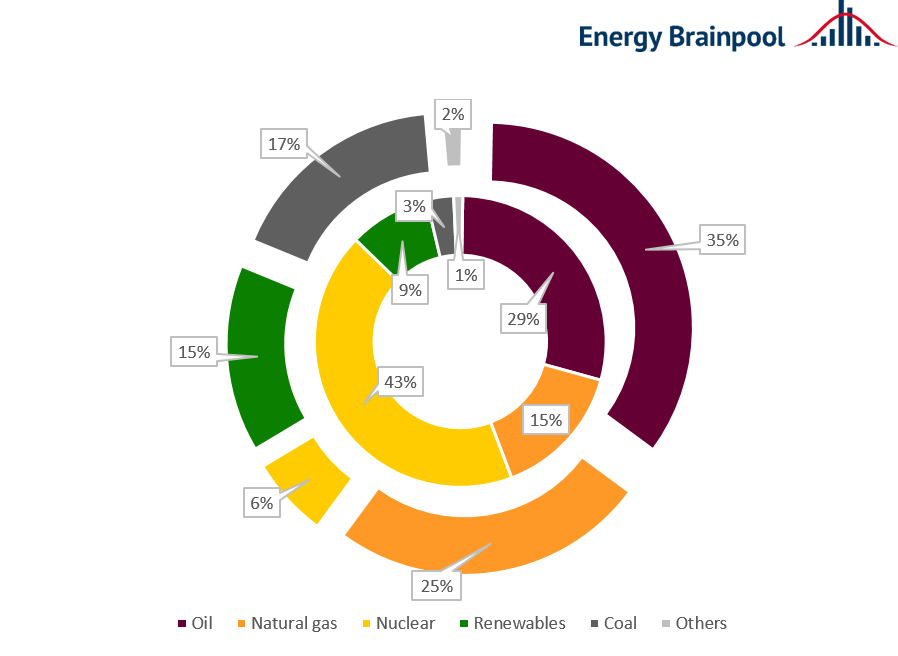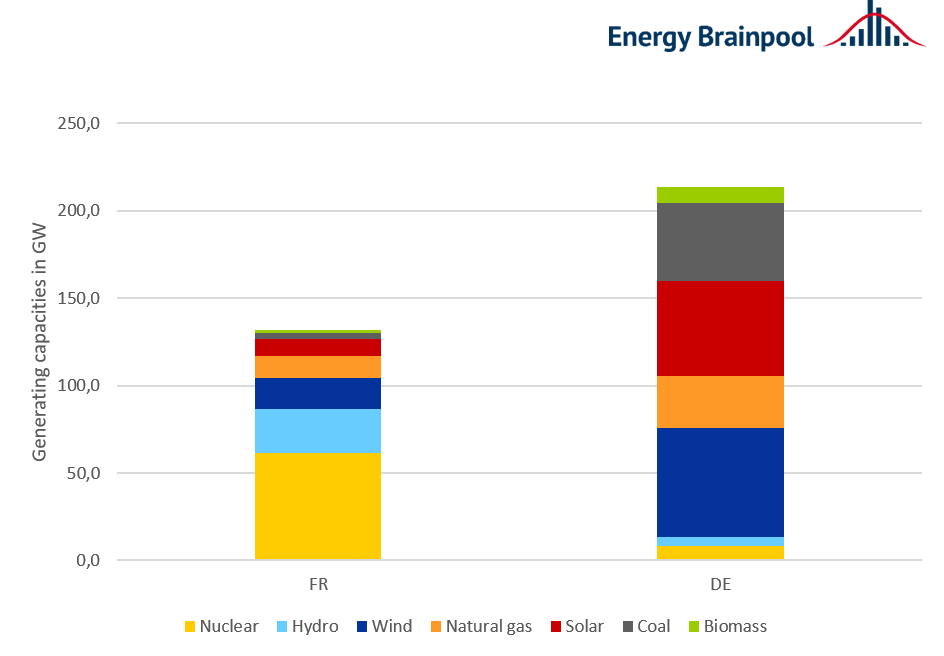Two different energy systems: France and Germany compared


· 6 min read
The energy systems of the two largest EU countries differ. A comparison of the electricity sectors in particular shows the contrasts. Electricity generation in France is dominated by nuclear power, which accounts for almost 70 percent, while Germany’s electricity mix relies on coal and natural gas as fossil fuels for one-third of the total. Follow us in this article as we explore the differences between the two energy systems.
Just by looking at the primary energy consumption of the two countries, the differences between France and Germany become clear. France’s primary energy consumption of about 10000 PJ was for many years about one third lower than that of Germany. However, in addition to the higher economic output, the high shares of coal-fired power generation in Germany also played an important role.
Primary energy consumption has been declining in both countries since 2010. Since that time, coal-fired power generation in Germany decreased (especially from 2017), while renewable energy shares grew. Renewable generation also increased in France during this period, but less so than in Germany. For example, primary energy consumption in France declined by 7.8 percent between 2010 and 2019, and by as much as 10 percent in Germany. The Corona pandemic led to an economic slump in both Germany and France, resulting in a drastic drop in energy consumption as shown in Figure 1 (source: AGEB, IEA).

While the share of oil in primary energy consumption is relatively similar in France and Germany, the shares for other energy sources lie far apart. In 2019, for example, nuclear energy accounted for 43 percent of French primary energy consumption. In contrast, with only 6 percent in Germany at that time. After 2023, the generation of electricity from nuclear power plants in Germany will decline to zero as the last reactors are shut down. There are also big differences in the share of coal. While hard coal and lignite still accounted for 17 percent of primary energy in Germany in 2019, the share of coal in France was only 3 percent in the same period (source: AGEB, Climate Transparency). Figure 2 illustrates the shares of different energy sources in primary energy supply in France (inner ring) and Germany (outer ring).

The higher shares of fossil fuels in Germany are also reflected in the greenhouse gas emissions balance. While French greenhouse gas emissions were 443 million metric tons CO2– eq. in 2019 (source: IEA), emissions in Germany stood at 800 million metric tons CO2-eq. according to the Federal Environment Agency (source: UBA). This means that France’s production-related greenhouse gas emissions before the Corona pandemic were almost 45 percent lower than in Germany.
In particular, France’s relatively low-CO2 electricity generation contributes to low climate-damaging emissions. The CO2-intensity of electricity generation in France stood at around 57 CO2/kWh in 2020 (source: Statista). In Germany, the electricity mix at the same time had a CO2-intensity of 366g CO2/kWh, which was more than six times higher (source: UBA). The explanation for this high discrepancy lies in the technologies used to generate electricity in the two countries.
German power generation capacity is best described as a colorful mix. With over 120 GW of renewable capacity and more than 70 GW of fossil power plants, Germany had a total capacity of over 220 GW of power plant capacity on the grid in 2020 (source: BDEW). In France, total capacity was just over 130 GW, with just under 60 GW of renewable capacity installed. At the same time, nuclear power plants account for the majority of French capacity, with over 61 GW of installed capacity (source: IEA). Figure 3 compares the generation capacities in the two countries.

France and Germany each produced about 525 TWh of electricity in 2020. To understand the low CO2-intensity of French power generation, it is necessary to look at actual power generation and not just installed capacity. Here, it becomes very clear how strongly nuclear power dominates the French electricity sector. Until before 2020, nuclear power usually accounted for over 70 percent of electricity generation in France. In 2020, however, nuclear generation declined to 67 percent, or just over 350 TWh, due to the closure of two plants. Hydropower generation was the second largest source, contributing just under 64 TWh of electricity (source: IEA).
German electricity generation presents a more diverse picture, with generation from fossil sources declining in 2020 compared to previous years due to pandemic-related impacts. The share of renewables in gross electricity generation in Germany reached the 45 percent mark in 2020 (source: BDEW). Figure 4 shows electricity generation in France and Germany by technology in 2020.

With the new traffic light coalition, the signs in Germany point to a faster implementation of the energy transition (see our report on the traffic light coalition). Also, under the impact of the armed conflict in Ukraine, Europe’s energy supply will not remain unchanged. Until now, natural gas was still politically high on the agenda as a bridge to climate neutrality. This has changed significantly after the events at the end of February 2022.
According to a key issues paper dated February 28, 2022, Germany is to achieve its power supply entirely from renewable energies by 2035. To this end, the output of onshore wind energy should double to up to 110 GW by 2030 (source: Handelsblatt).
With the inclusion of nuclear power plants in the EU taxonomy (here you can finde our detailed article on this topic), CO2-free generation in French nuclear power plants could develop even further. However, the fleet of power plants is aging and the commissioning of new power plants (Flamanville) has been repeatedly postponed while costs have increased (source: IWR).
The long-term outlook for nuclear power in France is uncertain. According to French President Macron, nuclear power is still entitled to a maximum of 40 percent of electricity generation in 2050 (source: Euractive).
Cooperation between the two countries regarding the transformation of their energy systems will certainly have to intensify in the coming years.
illuminem Voices is a democratic space presenting the thoughts and opinions of leading Energy & Sustainability writers, their opinions do not necessarily represent those of illuminem.
illuminem briefings

Hydrogen · Energy
illuminem briefings

Energy Transition · Energy Management & Efficiency
Vincent Ruinet

Power Grid · Power & Utilities
The Guardian

Rare Earths · Energy Sources
World Economic Forum

Renewables · Energy
Financial Times

Energy Sources · Energy Management & Efficiency